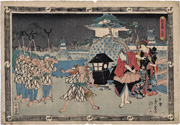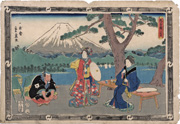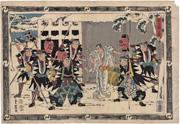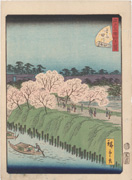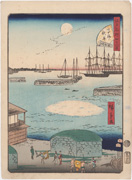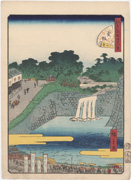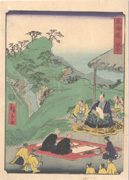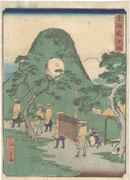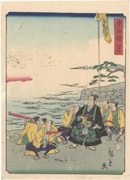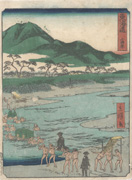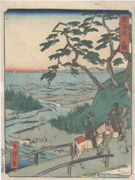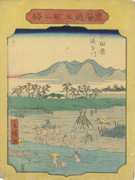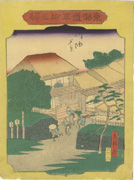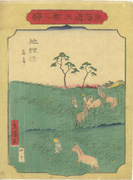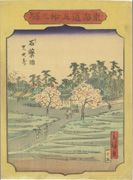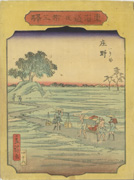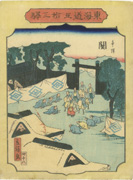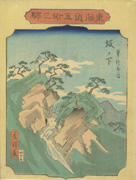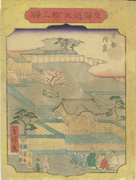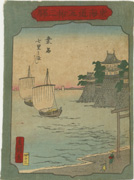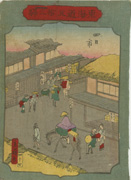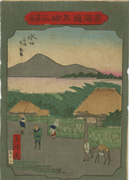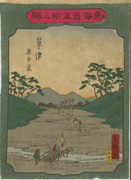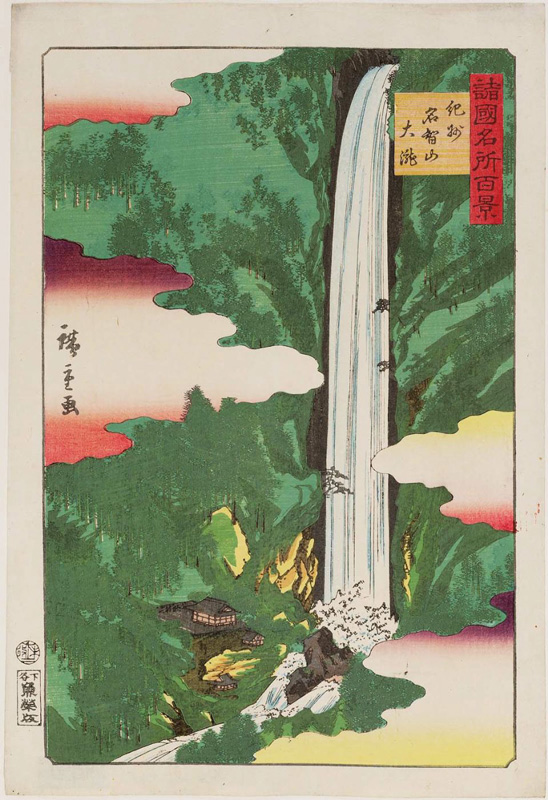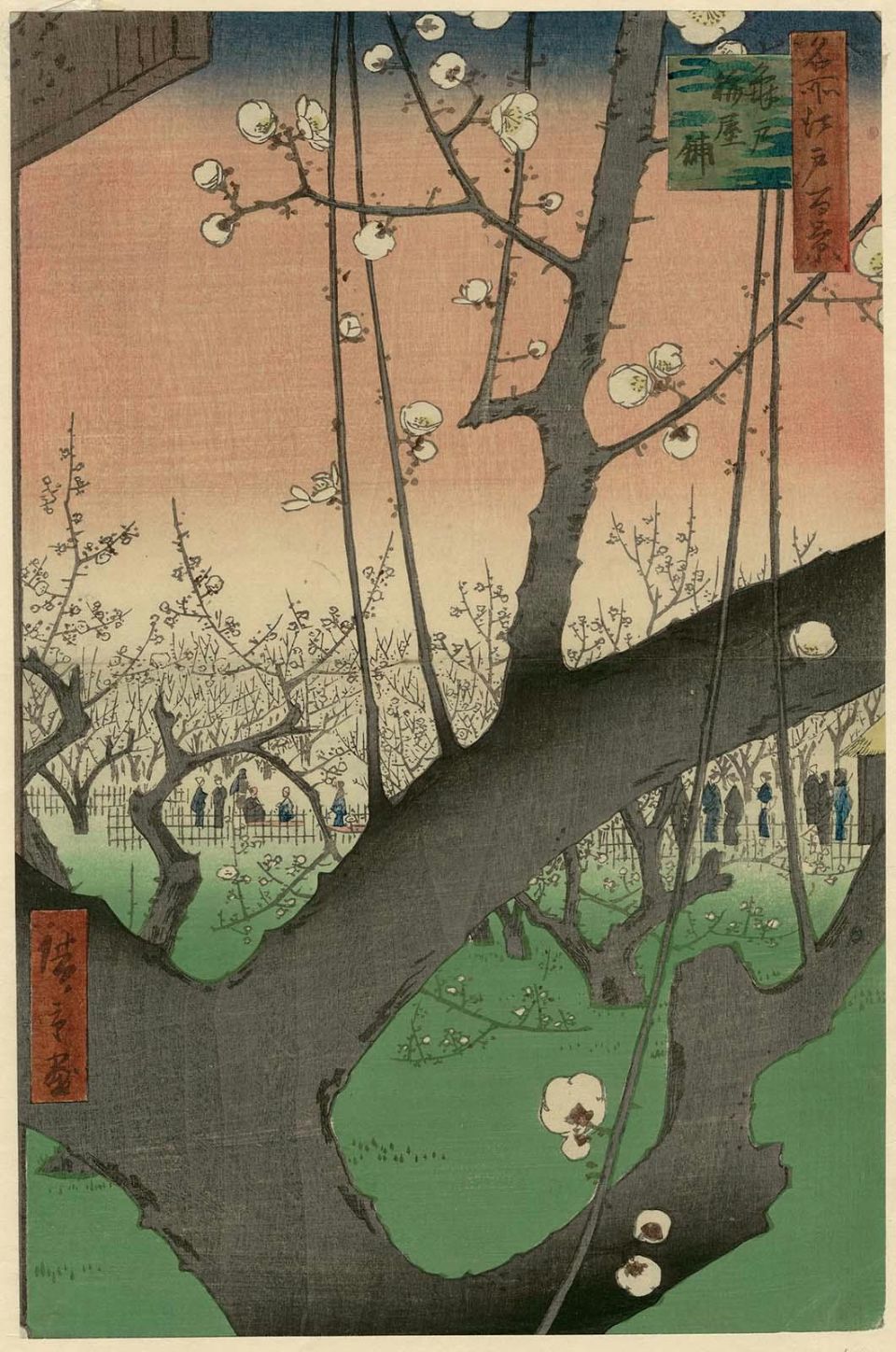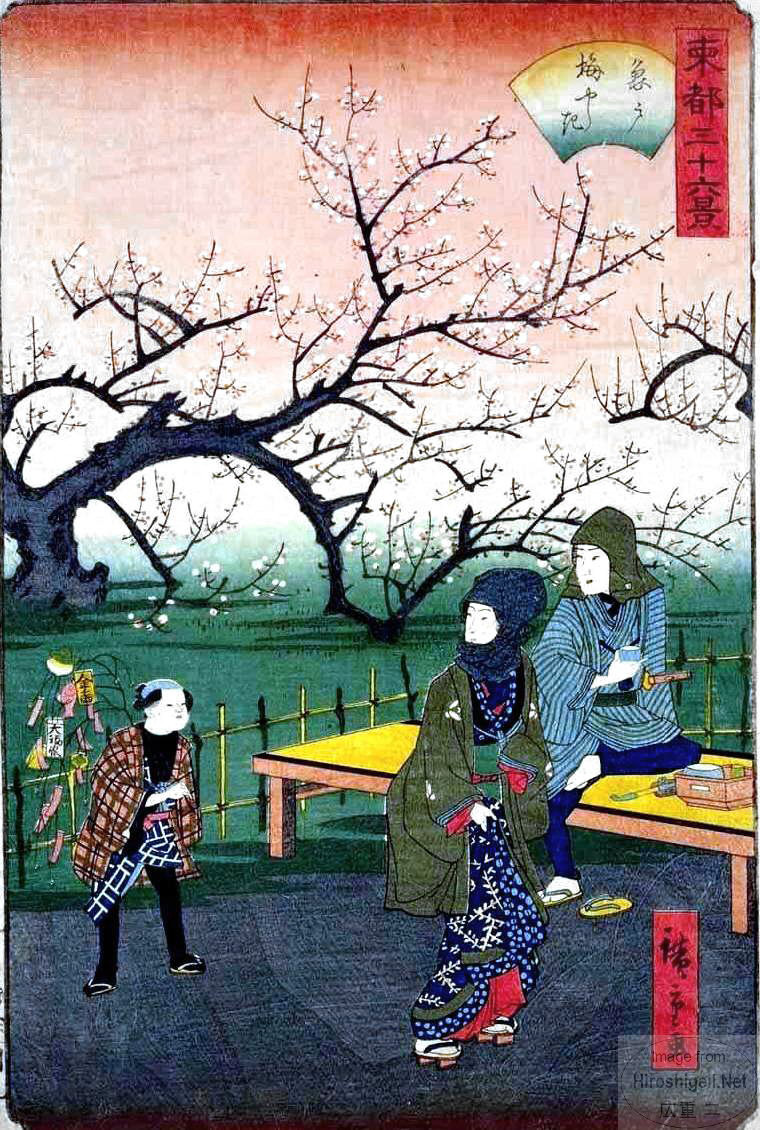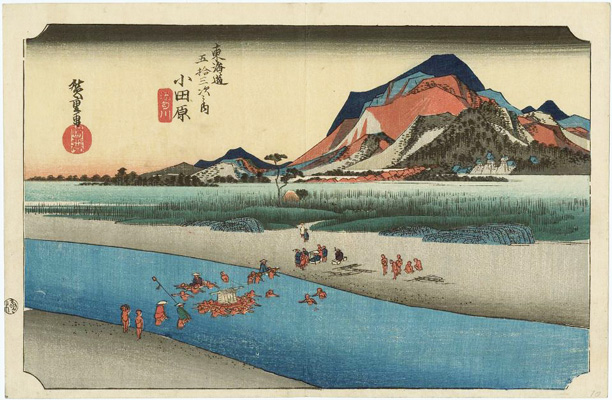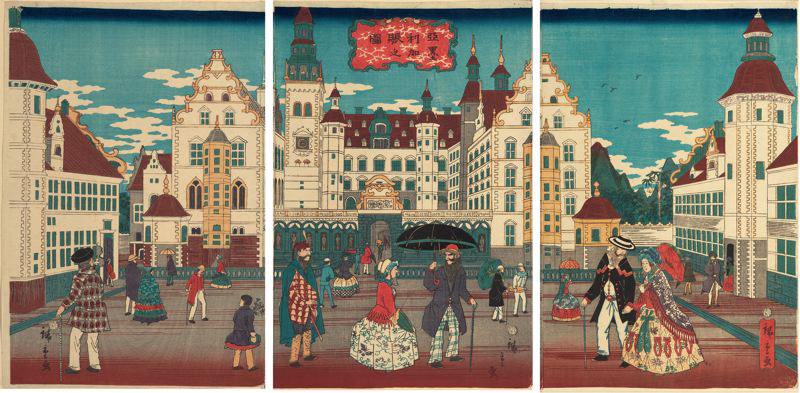Prints in Collection
The Storehouse of Loyal Retainers (Chūshingura), 1855
IHL Cat. #1151
IHL Cat. #1152
Sakanoshita from the series Tōkaidō Road, 1863
IHL Cat. #1199
Hiratsuka from the series Tōkaidō Road, 1863-1864
IHL Cat. #1201
Yokkaichi from the series Tōkaidō Road, 1864
IHL Cat. #1200
Odawara from the series Tōkaidō Road, 1867
IHL Cat. #1202
Ōiso from the series
Tōkaidō Road, 1867
IHL Cat. #1203
Biographical Data
Biography
Utagawa Hiroshige II 二代 歌川 広重 (1826-1869)Family name: Suzuki 鈴木. Given name: Chinpei 鎮平. Art surname: Utagawa 歌川. Artist names: Shigenobu 重宣, Hiroshige 広重 (II; from 1858). Art names: Ichiyūsai 一幽斎(c. 1853-58), Ryūsai 立斎 (c. 1859-63), Ichiryūsai 一立斎(c. 1860-61), Ryūshō/Risshō 立祥, Kisai 喜斎 (from 1865).
Note on sources: Bits and pieces of Hiroshige's II biography are available from multiple sources. The following is taken from Marks' comprehensive and succinct biography referenced below. Footnotes, bracketed information and illustrations are my own and do not appear in the original text. For an earlier (1927) fascinating account of Hiroshige II see Chapter III of Strange's The Colour-Prints of Hiroshige wonderfully reproduced at http://www.hiroshige.org.uk/hiroshige/strange/chapter_03.htm
Source: Japanese Woodblock Prints: Artists, Publishers and Masterworks 1680-1900, Andreas Marks, Tuttle Publishing, 2010, p. 154.
Hiroshige II is generally neglected because he followed his teacher Hiroshige very closely and focused on the same motifs. It is this closeness and the similarity in signatures that led early Western scholars to even deny his existence.
 "Hiroshige ga" |  "Hiroshige ga" |
Shigenobu’s first illustrated book, of the roughly 20 he illustrated during his career, is Twenty-Four Paragons of Japan and China (Wakan nijūshi kō) from 1849. This is also the earliest dateable work by him. Obviously Shigenobu was Hiroshige’s best student as he received a number of orders for books as well as prints. In the early 1850s, he sometimes signed his works “Ichiryūsai mon” (student of Ichiryūsai), referring to Hiroshige’s art name. From c. 1853 until 1858, Shignenobu employed the art name Ichiyūsai in his works. After Hiroshige passed away in late 1858, he married Hiroshige’s sixteen-year-old daughter Otatsu and inherited the name Hiroshige. [He also received Hiroshige's wakizashi (samurai’s short sword) as a ‘memento’ after his death]2. Like his teacher, he used from this point on the art names Ichiryūsai and Ryūsai. The marriage was dissolved in 1865 and Hiroshige II moved from Edo to Yokohama and changed his name from Hiroshige to Ryūshō/Risshō (both pronunciations are possible). At this point he also started to use the art name Kisai.
| The Great Waterfall at Mount Nachi in Kii Province (Kishu Nachisan odaki), from the series One Hundred Famous Views in the Various Provinces (Shokoku meisho hyakkei)1859, 12th month Museum of Fine Arts, Boston Accession Number 11.16873 | In the early 1860s, Hiroshige II was involved in several series where two or more artists collaborated. Like Hiroshige before him, he often worked with Kunisada [Utagawa Kunisada I (1786–1865)] and drew the landscapes or insets in their collaborative works, e.g. in Pride of Edo: Thirty-Six Amusements (Edo jiman sanjūrokkyō) from 1864. In late 1858, shortly after Hiroshige’s death, he worked with Hiroshige’s old artistic partner Kunisada in the series Record of Kannon’s Miracles (Kannon reigenki). From 1859 until 1861, One Hundred Famous Views of the Provinces (Shokoku meisho hyakkei) was published, one of Hiroshige II’s most popular series. Throughout his career he designed many sets of views of Edo, especially Thirty-Six Views of the Capital (Tōto sanjūrokkei), issued 1861-62. In 1862, he contributed to the series Flowers of Edo—A Gathering of Beautiful Places (Edo no hana – Meishō-e), a two and a half year long collaborative project commissioned under the lead of Kunisada. Hiroshige II was one of the principal artists of the Go-jōraku Tōkaidō project in 18633 and did other Tōkaidō series thereafter. Apart from prints, Hiroshige II also produced a number of fine paintings. [Examples of which can be found below.] [The artist also created a number of wonderful Yokohama-e prints such as A Picture of Prosperity: America (Amerika shin no zu), 1861 shown below.] Works from his last years are scarce. In order to make a living he had turned to decorating lanterns, kites, and especially tea chest (chabako) for export, thus he became known as “Tea chest Hiroshige” (Chabako Hiroshige). On September 17, 1869, Hiroshige II died at the age of 44.4 |
1 It is reported in The Hotei Encyclopedia of Japanese Woodblock Prints, Amy Reigle Newland, Hotei Publishing Company, 2005, p. 504 that "he reportedly became a pupil of Utagawa Hiroshige I in his middle teens."
2 The Hotei Encyclopedia of Japanese Woodblock Prints, Amy Reigle Newland, Hotei Publishing Company, 2005, p. 504
3 Hiroshige II was one of a group of thirteen artists and sixteen publishers who collaborated to produce an extensive series of 165 or more designs featuring the journey of the Shogun and his procession along the Tōkaidō Highway, published mainly in the summer of 1863, the so-called 'Progress to Kyoto' ('go-joraku') Tōkaidō series. Hiroshige II contributed nine of the designs. (British Museum website curator Timothy Clark comment.)
Indeptedness to His Master
Source: Competition and Collaboration: Japanese Prints of the Utagawa School, Laura J. Mueller, Chazen Museum of Art in association with Hotei Publishing, 2007, p. 196 -197.There are numerous examples in Hiroshige II's work of his paying homage to his master. Such an example is his The Plum Orchard at Kameido (Kameido umeyashiki) from Thirty-six Views of the Eastern Capital (Tōto sanjūrokkei), April 1862 shown below to the right of his master's similarly titled print.
Utagawa Hiroshige I Plum Estate, Kameido (Kameido Umeyashiki) from the series One Hundred Views of Famous Places in Edo (Meisho Edo hyakkei), 1857 11th month Museum of Fine Arts, Boston Accession Number 11.20206 | Utagawa Hiroshige II The Plum Orchard at Kameido (Kameido Umeyashiki) from the series Thirty-Six Views of the Eastern Capital (Tōto sanjūrokkei), 1862 4th month |
The 1865 Series Tōkaidō gojūsan eki (Fifty-three Stations of the Tōkaidō)
Source: J. Noel Chiappa's website www.hiroshigeii.netIn 1865, four years before his death, Hiroshige II produced his third and last solo1 Tōkaidō series.2
This vertical chūban-size series (about 10" x 7 1/4") was issued in at least three different editions as shown below. Two of them, the most common yellow bordered edition and the "crêped"3 edition, are represented in this collection.
Hiroshige II's teacher, Hiroshige I [Utagawa (Ando) Hiroshige 1795-1858], designed his masterpiece series of the same name, Fifty-three Stations of the Tōkaidō (also known as the First Tōkaidō or Great Tōkaidō) c. 1832. Hiroshige I's series of prints were done in a landscape (horizontal) orientation and were larger ōban-size prints (roughly 10" x 15".) Hiroshige II has, for the most part, used similar views of each station as did his master in the original 1832 series.
The Tōkaidō, connecting Edo with Kyoto, was one of three major roads connecting Edo with other major cities. "Travel on the Tōkaidō from Edo to Kyoto took fourteen to fifteen days in good weather to walk the distance, over 300 miles. When it rained and the rivers overflowed, travelers could be delayed for days, requiring more time and money. Despite the hazards and difficulties, many people traveled the Tōkaidō Road - daimyo and their entourages, merchants on business, and private people who were sightseeing or on the way to temples and shrines."5
1 He participated in two collaborative Tōkaidō series with other artists in 1863 and again in 1865.
2 The other two series are the 1854 series Tōkaidō gojūsan tsugi (Fifty-three Stages of theTōkaidō) issued in the small horizontal yotsugiri-size (about 5" x 7") and the 1862 vertical chūban-size series Tōkaidō.
3 See "chirimen-e" in the Glossary for an explanation of this process.
4 The 58 prints are made up of the 55 views of the 53 stations (includes two alternate states of prints for Minakuchi the 51st station and Ishibe the 52nd station) plus the Nihonbashi starting point print and two Kyoto terminus point prints.
5 Hokusai and Hiroshige: Great Japanese Prints from the James. A. Michener Collection, Honolulu Academy of Arts, Julia M. White, et. al., The Asian Art Museum of San Francisco, 1998.p. 158.
Arthur Davison Ficke, 1917
"Some of the work of Hiroshige II is very good; upon the accidental destruction of one of the plates of [Hiroshige I's] the 'One Hundred Yedo Series,' he produced a new design that is admirable. But he lacked originality, and at his best merely trod in the footsteps of his master. Most of his designs are flat and uninspired."1
Basil Stewart, 1917
"Of Hiroshige's pupil, Utagawa (or Ichiyusai) Shigenobu (w. 1840-1868), afterwards Hiroshige II, little need be said. As a rule his work, which closely follows that of his master, is very inferior, though at times it was of sufficient merit to favourably compare with it."2
Edward F. Strange, 1925
"It is interesting to note that the 'mysterious' Hiroshige II was among the first Japanese artists to exhibit in Europe. That fact alone is some sort of testimonial to a degree of artistic merit which has been admitted by several modern Japanese critics."3
Laurance P. Roberts, 1976
"His work varies; his prints, at best, a good imitation of his master’s but much is hasty and superficial; his paintings almost as fine as Hiroshige’s."4
Oikawa Shigeru, 2005
“In the last years of Edo and in early Meiji designers such as the Utagawa artists Kuniaki (act. C. 1855-65), Hiroshige II (1826-69) and Hiroshige III (1842/43-94), Hirokage (act. C. 1855-65), as well as Yoshiiku [Utagawa Yoshiiku (1833-1904)], Yoshitoshi [Tsukioka Yoshitoshi (1839-1892)] and Kunichika [Toyohara Kunichika (1835–1900)], produced prints that equaled any earlier prints in terms of artistic and technical excellence."5
1 Chats on Japanese Prints, Arthur Davison Ficke, Frederick A. Stokes Company, 1917, p. 397-398.
2 On Collecting Japanese Colour-Prints, Basil Stewart, New York, Dodd, Mead & Company, 1917, p. 87.
3 The Colour-Prints of Hiroshige, Edward F. Strange, Cassell & Company, Ltd., 1925, ch. 3.
4 A Dictionary of Japanese Artists: Painting, Sculpture, Ceramics, Prints, Lacquer, Laurance P. Roberts, Weatherhill, 1976, p. 45.
5 "The Maintenance of Tradition in the Face of Contemporary Demands: A Reassessment of Meiji Prints", Oikawa Shigeru, appearing in The Hotei Encyclopedia of Japanese Woodblock Prints, Amy Reigle Newland, Hotei Publishing Company, 2005, p. 262.
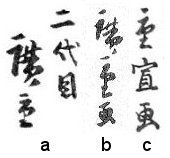
a) ''nidaime'' Hiroshige, b) Hiroshige ''ga'', and c) Shigenobu ''ga''
This vertical chūban-size series (about 10" x 7 1/4") was issued in at least three different editions as shown below. Two of them, the most common yellow bordered edition and the "crêped"3 edition, are represented in this collection.
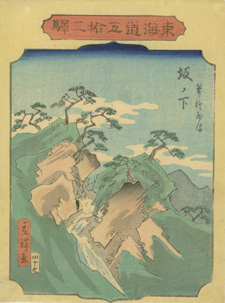 Oct. 1865 (yellow border as originally issued) | 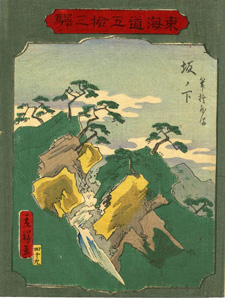 (green border issued after Oct. 1865) | 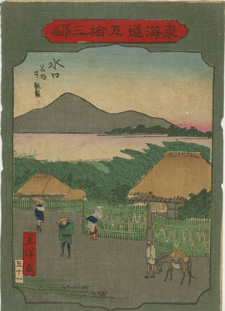 (green chirimen-e, after Oct. 1865) |
Each print in the series is signed "Risshō ga" and contains the series title within a horizontal cartouche at the top of the print along with the title of each individual print within the top part of the image.
Starting with Nihonbashi (the starting point located in Edo for measuring all distances) and ending with Kyoto's Imperial Palace, the series portrayed all 53 stations along the Tōkaidō and contained a total of 58 prints.4Hiroshige II's teacher, Hiroshige I [Utagawa (Ando) Hiroshige 1795-1858], designed his masterpiece series of the same name, Fifty-three Stations of the Tōkaidō (also known as the First Tōkaidō or Great Tōkaidō) c. 1832. Hiroshige I's series of prints were done in a landscape (horizontal) orientation and were larger ōban-size prints (roughly 10" x 15".) Hiroshige II has, for the most part, used similar views of each station as did his master in the original 1832 series.
| Utagawa Hiroshige I Odawara, Sakawagawa from the series Fifty-three Stations of the Tokaido, c. 1833-34 Museum of Fine Arts, Boston 11.30190 | Utagawa Hiroshige II Odawara from the series Fifty-three Stations of the Tokaido, 1865 from this collection |
1 He participated in two collaborative Tōkaidō series with other artists in 1863 and again in 1865.
2 The other two series are the 1854 series Tōkaidō gojūsan tsugi (Fifty-three Stages of theTōkaidō) issued in the small horizontal yotsugiri-size (about 5" x 7") and the 1862 vertical chūban-size series Tōkaidō.
3 See "chirimen-e" in the Glossary for an explanation of this process.
4 The 58 prints are made up of the 55 views of the 53 stations (includes two alternate states of prints for Minakuchi the 51st station and Ishibe the 52nd station) plus the Nihonbashi starting point print and two Kyoto terminus point prints.
5 Hokusai and Hiroshige: Great Japanese Prints from the James. A. Michener Collection, Honolulu Academy of Arts, Julia M. White, et. al., The Asian Art Museum of San Francisco, 1998.p. 158.
Critical Views of Artist's Work
Due to confusion about Hiroshige's II identity, or even existence, early Western commentators on Japanese prints generally dismissed his work as purely derivative of his master's. The derivative nature of much of Hiroshige II's early work is not surprising as part of a student's training was to copy his teacher's work. I'll also add that the sheer volume of designs demanded by publishers during the period Hiroshige II worked resulted in a lot of pedestrian and "uninspired" prints by some very good artists. As time went on more favorable views, although not universal, have been expressed of his work and other "secondary" artists of the period.Arthur Davison Ficke, 1917
"Some of the work of Hiroshige II is very good; upon the accidental destruction of one of the plates of [Hiroshige I's] the 'One Hundred Yedo Series,' he produced a new design that is admirable. But he lacked originality, and at his best merely trod in the footsteps of his master. Most of his designs are flat and uninspired."1
Basil Stewart, 1917
"Of Hiroshige's pupil, Utagawa (or Ichiyusai) Shigenobu (w. 1840-1868), afterwards Hiroshige II, little need be said. As a rule his work, which closely follows that of his master, is very inferior, though at times it was of sufficient merit to favourably compare with it."2
Edward F. Strange, 1925
"It is interesting to note that the 'mysterious' Hiroshige II was among the first Japanese artists to exhibit in Europe. That fact alone is some sort of testimonial to a degree of artistic merit which has been admitted by several modern Japanese critics."3
Laurance P. Roberts, 1976
"His work varies; his prints, at best, a good imitation of his master’s but much is hasty and superficial; his paintings almost as fine as Hiroshige’s."4
Oikawa Shigeru, 2005
“In the last years of Edo and in early Meiji designers such as the Utagawa artists Kuniaki (act. C. 1855-65), Hiroshige II (1826-69) and Hiroshige III (1842/43-94), Hirokage (act. C. 1855-65), as well as Yoshiiku [Utagawa Yoshiiku (1833-1904)], Yoshitoshi [Tsukioka Yoshitoshi (1839-1892)] and Kunichika [Toyohara Kunichika (1835–1900)], produced prints that equaled any earlier prints in terms of artistic and technical excellence."5
1 Chats on Japanese Prints, Arthur Davison Ficke, Frederick A. Stokes Company, 1917, p. 397-398.
2 On Collecting Japanese Colour-Prints, Basil Stewart, New York, Dodd, Mead & Company, 1917, p. 87.
3 The Colour-Prints of Hiroshige, Edward F. Strange, Cassell & Company, Ltd., 1925, ch. 3.
4 A Dictionary of Japanese Artists: Painting, Sculpture, Ceramics, Prints, Lacquer, Laurance P. Roberts, Weatherhill, 1976, p. 45.
5 "The Maintenance of Tradition in the Face of Contemporary Demands: A Reassessment of Meiji Prints", Oikawa Shigeru, appearing in The Hotei Encyclopedia of Japanese Woodblock Prints, Amy Reigle Newland, Hotei Publishing Company, 2005, p. 262.
A Few Other Works
A Picture of Prosperity: America (Amerika shin no zu) (1861) by Utagawa Hiroshige II "For this print, Hiroshige II worked from an engraving of a Danish castle that appeared in The Illustrated London News and created an image of a bustling city square surrounded by baroque-style buildings, mountains, and palm trees." Art Institute of Chicago, 1926.1787 http://www.artic.edu/aic/visitor_info/selfguide/september08_guide.pdf |
Signatures
Source: Wikipedia http://en.wikipedia.org/wiki/Hiroshige_II
a) ''nidaime'' Hiroshige, b) Hiroshige ''ga'', and c) Shigenobu ''ga''
